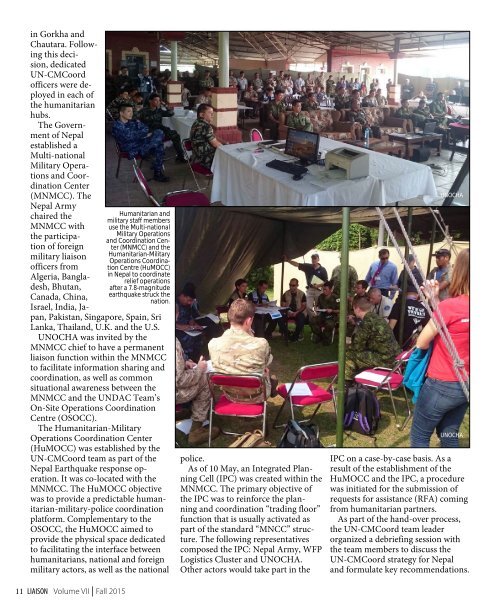LIAISON
1P9ozCB
1P9ozCB
You also want an ePaper? Increase the reach of your titles
YUMPU automatically turns print PDFs into web optimized ePapers that Google loves.
in Gorkha and<br />
Chautara. Following<br />
this decision,<br />
dedicated<br />
UN-CMCoord<br />
officers were deployed<br />
in each of<br />
the humanitarian<br />
hubs.<br />
The Government<br />
of Nepal<br />
established a<br />
Multi-national<br />
Military Operations<br />
and Coordination<br />
Center<br />
(MNMCC). The<br />
Nepal Army<br />
chaired the<br />
MNMCC with<br />
the participation<br />
of foreign<br />
military liaison<br />
officers from<br />
Algeria, Bangladesh,<br />
Bhutan,<br />
Canada, China,<br />
Israel, India, Japan,<br />
Pakistan, Singapore, Spain, Sri<br />
Lanka, Thailand, U.K. and the U.S.<br />
UNOCHA was invited by the<br />
MNMCC chief to have a permanent<br />
liaison function within the MNMCC<br />
to facilitate information sharing and<br />
coordination, as well as common<br />
situational awareness between the<br />
MNMCC and the UNDAC Team’s<br />
On-Site Operations Coordination<br />
Centre (OSOCC).<br />
The Humanitarian-Military<br />
Operations Coordination Center<br />
(HuMOCC) was established by the<br />
UN-CMCoord team as part of the<br />
Nepal Earthquake response operation.<br />
It was co-located with the<br />
MNMCC. The HuMOCC objective<br />
was to provide a predictable humanitarian-military-police<br />
coordination<br />
platform. Complementary to the<br />
OSOCC, the HuMOCC aimed to<br />
provide the physical space dedicated<br />
to facilitating the interface between<br />
humanitarians, national and foreign<br />
military actors, as well as the national<br />
Humanitarian and<br />
military staff members<br />
use the Multi-national<br />
Military Operations<br />
and Coordination Center<br />
(MNMCC) and the<br />
Humanitarian-Military<br />
Operations Coordination<br />
Centre (HuMOCC)<br />
in Nepal to coordinate<br />
relief operations<br />
after a 7.8-magnitude<br />
earthquake struck the<br />
nation.<br />
police.<br />
As of 10 May, an Integrated Planning<br />
Cell (IPC) was created within the<br />
MNMCC. The primary objective of<br />
the IPC was to reinforce the planning<br />
and coordination “trading floor”<br />
function that is usually activated as<br />
part of the standard “MNCC” structure.<br />
The following representatives<br />
composed the IPC: Nepal Army, WFP<br />
Logistics Cluster and UNOCHA.<br />
Other actors would take part in the<br />
UNOCHA<br />
UNOCHA<br />
UNOCHA<br />
IPC on a case-by-case basis. As a<br />
result of the establishment of the<br />
HuMOCC and the IPC, a procedure<br />
was initiated for the submission of<br />
requests for assistance (RFA) coming<br />
from humanitarian partners.<br />
As part of the hand-over process,<br />
the UN-CMCoord team leader<br />
organized a debriefing session with<br />
the team members to discuss the<br />
UN-CMCoord strategy for Nepal<br />
and formulate key recommendations.<br />
Figure 1: Cyclone Pam in Vanuatu and the Nepal Earthquake were used to validate the Typhoon Haiyan after-action report recommendations.<br />
11 <strong>LIAISON</strong> Volume VII | Fall 2015 Center for Excellence in Disaster Management & Humanitarian Assistance 12


